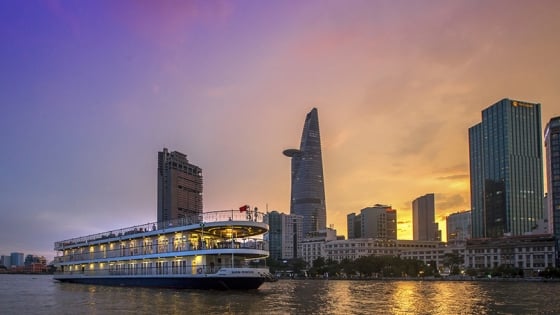Jackie Ong, Justin Matthew Pang
Thursday, July 4, 2024 | 9:00 AM GMT+7
Customising products to suit traveller budgets and inviting international cruise tourists on board is the solution for Vietnam’s waterway tourism, writes Dr Jackie Ong, senior program manager for RMIT’s Tourism and Hospitality Management programme, and Dr Justin Matthew Pang, RMIT associate program manager for the programme.

A cruise ship sails on the Saigon River in Ho Chi Minh City, southern Vietnam. Photo credit: government news portal.
Day and weekend trips to major cities like Hanoi, Ho Chi Minh City and Da Nang feature scenic cruises with dining, live music and cultural performances, as well as kid-friendly activities and educational content on local history and ecology.
Highlight Vietnam’s historical and cultural importance with tours of ancient riverside temples, pagodas, traditional villages and historic sites, or tours of the Mekong Delta’s bustling floating markets provide insight into local commerce, cuisine and daily life on the water. Nature lovers will be drawn to ecotourism promotions, including bird watching, visiting mangrove forests and exploring national parks by boat.

Dr Jackie Ong, Senior Program Manager, RMIT Tourism and Hospitality Management Program. Photo courtesy of RMIT.
There are different options to suit different audiences.
For the adventurous, water sports such as kayaking, canoeing, paddle boarding, jet skiing and water skiing are attractive options in beautiful locations like Halong Bay and the Mekong Delta.
Food lovers can enjoy gourmet cruises offering Vietnamese cuisine, food tours with cooking classes, tastings and visits to riverside eateries and markets, and floating restaurants offering a unique dining experience on the water.
Festivals and events such as traditional boat races, lantern festivals and music performances can create a festive atmosphere to attract domestic tourists. In addition, holiday-themed cruises such as Tet (Lunar New Year) and National Day can add excitement and attraction.
Finally, wellness cruises, with their emphasis on relaxation through spa treatments, yoga sessions and meditation, can satisfy the desires of those seeking tranquility and rejuvenation.
Welcoming international cruise passengers on board
According to the World Tourism Organization, cruise tourism generates 40% more revenue than air and land tourism. Vietnam should market to more Asian countries such as South Korea, Singapore, Japan and India for cruise tourism. 70% of foreign tourists visiting Vietnam in 2022 are from Asia, and many tourists from these countries are known to be avid cruise travelers.

Dr Justin Matthew Pang, Associate Program Manager, Tourism and Hospitality Management Program, RMIT. Photo courtesy of RMIT.
It is crucial for Vietnam to improve training for service staff to better manage operations at ports and on cruise ships, including boarding, food and beverage management, recreational skills and cabin operations.
A persuasive staffer might encourage passengers to dine in the ship’s fine restaurants rather than in the main all-inclusive dining hall that is part of the package. Revenue also comes from paid activities, such as on-board or shore tours.
Vietnam needs to improve its port facilities, such as guest lounges and passenger embarkation and disembarkation facilities, as well as provide more on-the-sea activities for passengers to enjoy when their ships are in port. For Vietnam to succeed in the luxury cruise tourism sector, it is essential to develop its brand and provide an exceptional and memorable experience.

